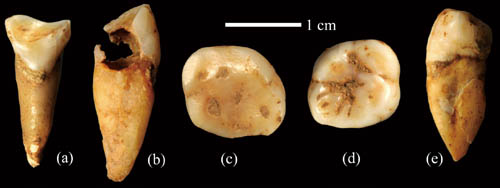Human intelligence not really linked to frontal lobe.
New research highlights that the human frontal lobe is not oversized in comparison with other animals. Instead the human intelligence seems to be distributed through all the brain, being the network what really matters → Science Daily.
Ref. Robert A. Barton and Chris Venditti. Human frontal lobes are not relatively large. PNAS, May 13, 2013 DOI: 10.1073/pnas.1215723110
Early hominin ear bones found together in South Africa.
The three bones, dated to c. 1.9 Ma show intermediate features between modern humans and apes → PhysOrg.
New hominin site in Hunan (China).
The sediments of Fuyan cave, in which five human teeth (Homo erectus?) were found, along with plenty of animal ones, are dated to 141,700 (±12,100) years ago. → IVPP - Chinese Academy of Sciences.
 |
| The five human teeth |
Neanderthal workshop found in Poland.
In Pietrowice Wielkie (Silesia), which is at the end of a major natural corridor from the Danubian basin → PAP.
Ancient Eastern Europeans ritually killed their pets to become warriors.
In the Bronze Age site of Krasnosamarkskoe (Volga region, Russia) more than 50 ritually pieced skulls of dogs have puzzled archaeologists, who have reached the conclusion, after researching Indoeuropean accounts from India, that the animals may have been killed in adulthood rituals: the boys who were to become warriors had to kill their most beloved pet in order to be accepted as such, and did so in a precise and macabre ritual → National Geographic.
Ancient log boat found in Ireland.
In the Boyne river, which was in the past a major artery of the island. Not yet dated: it could be from prehistoric times or the 18th century. → Irish Times.


Hey maju, you notice this?
ReplyDeletehttp://fennoscandia.blogspot.com/2013/05/la-brana-individuals-and-1000g-european.html?m=1
Yes, I read it. It did not seem much novelty after what was discussed here, based mostly on Dienekes.
DeleteAnyhow, we still can't be sure if the La Braña pair are Epipaleolithic or Neolithic: their dating is borderline, the cave not used before and the flexed burials are much more typical of Neolithic people.
Besides I don't understand well Chromopainter and, if it has anything to do with TreeMix, as I believe, I'd rather not rely on it at all.
Dienekes didnt have much samples from the far North and he didnt have 68k markers neither when creating his calculator. Vadim Verenich commented this fact in a post on a blog earlier.
ReplyDeletehttp://verenich.wordpress.com/2013/06/06/еще-раз-к-проблеме-генетической-преем/
(Use Google translator to get an idea of the content)
Did it.
DeleteOne thing I see is that the value differences are not very notable, as if Bra would reject to be clustered with any other: while Lithuanians rank highest and the Gumuz lowest, the difference, the most extreme one is of just 0.0759, which looks very much not significant and all being intermediate values (~0.5), i.e. "yes but not".
In the Crhomopainter analysis (and unlike in yours) Bra clearly clusters out of all other Europeans, being also a very weak donor but a rather strong receptor, what would be most strange if ancestral. The (relatively) strongest Bra donations are to two individuals, one Estonian and the other Lithuanian. Still I would like to see CP comparison with wider populations (he mentions "Basques" but I suspect it a Google Translate error: "басками" is not quite like "баскский", which is what Wikitionary finds as "Basque" in Russian, maybe Bashkirs?)
It seems that Bra just refuses to allow classification at autosomal level. Best to wait for future sequences IMO.
Anders PålsenJune 24, 2013 at 8:10 PM
DeleteThis is simply because of the African minority admixture in the La Braña, you see it it the mutation output file from Chromopainter where the differenational is high. Its not at the same rate as original Africans like Pygmys, San and Yoruba but still considerable.
Maju wrote "being also a very weak donor but a rather strong receptor"
We don't even know for sure if that admixture is African or Asian (or something else). Whatever the case Chromopainter goes chunk by chunk, so that part won't weight more than it actually weights (c. 10%). It seems that Braña can be largely (not much more than 50% in any case) with other European donors but it does not paint them almost, so... well, just some sort of unclear relationship. The sequence is in any case too short, and composite of two individuals, maybe not even related, to be too informative. We can't waste so much time discussing something so evasive.
DeleteAfrican admixture is easy to identify as they are clearly different from others, they (La Braña) pull towards the Africans in the PCA and in the heatmaps. In the Chromopainter mutation count file they show increased mutations counts vs other populations. As a result they show far higher diversity than most European modern populations. This also result in a African like Paint vs donate profile of the La Braña vs other European populations.
DeleteReplyDelete
Btw, why have you moved the discussion to this, seemingly unrelated thread. Please go back to the La Braña one: http://forwhattheywereweare.blogspot.com/2012/06/more-north-iberian-epipaleolithic-mtdna.html
DeleteDienekes first identified it as NW African, what seems to make sense but either we have to admit that there was NW African ancestry in West Iberia at frequencies similar, or rather higher, as those of today already in the Paleolithic, or we have to think that Bra is Neolithic in fact.
... but another Dienekes comparison made it ~10% East Asian instead, while one by Zack (of Harappa Ancestry Project) made it 7% Siberian and 6% San.
DeleteSorry the first Dienekes comparison made Bra to be some 12% East African, not NW African (that's Ötzi).
DeleteThis comment has been removed by the author.
ReplyDeleteThis comment has been removed by the author.
ReplyDelete